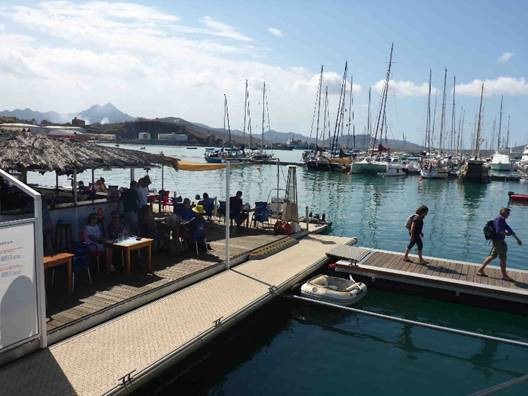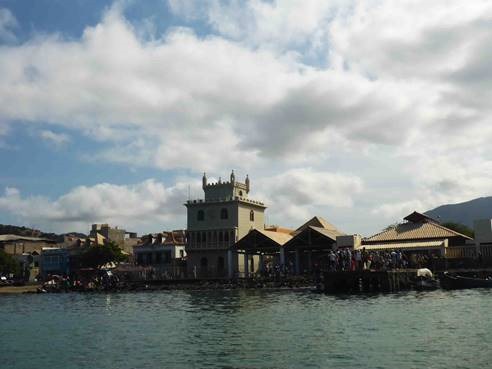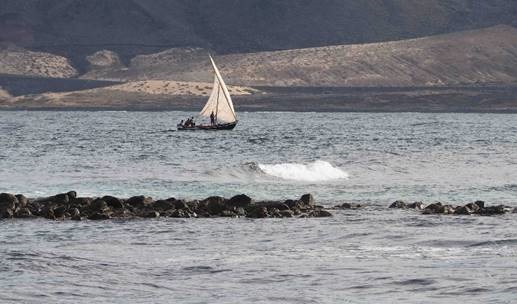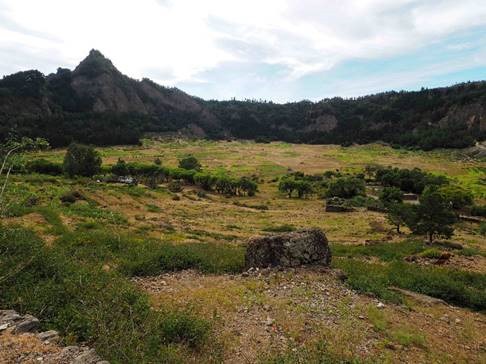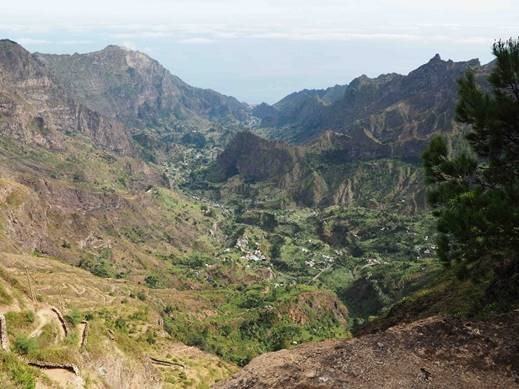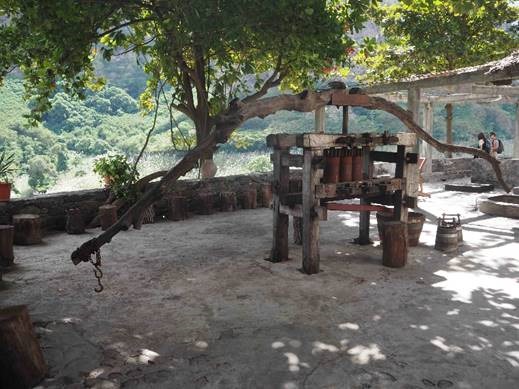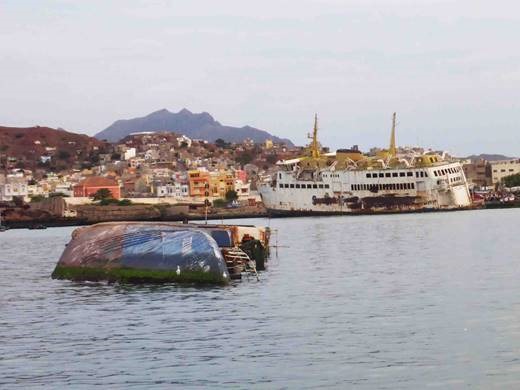25 November - Basecamp Mindelo

|
16:53N 25:00W Later in the morning of 17 November, after a few hours of kip, we went into the marina at Mindelo. It is a modern, well organised place nestling in the north east corner of the harbour and well placed for going into town. We were ‘Mediterranean moored’ – stern to the pontoon with a rather weed-encrusted line from the bows holding us off. Amazingly, we were next to our Kiwi friend David, last seen all those weeks ago in Lisbon and who came with us on our day trip to Sintra. It was good to catch up with his news and meet his current crew, a father and son from Poole who will be with the boat for several months.
Mindelo Marina The team from A Capella of Belfast came to say hello – they had got alongside an hour earlier. Their boat is absolutely brand new and Julian, the owner, is a fastidious skipper. A Hereford farmer who ‘sold up’ to finance a five year circumnavigation, this is a chap with just about everything onboard you could possibly need. Their ‘twin cabin’ has been converted into a fully fitted storeroom and workshop and would not be out of place in a minehunter. His ‘security devices’ include a murderous looking cutlass ‘for filleting fish’, remote alarms, high powered searchlights, mini-flares to fire out of the accommodation to attract attention… I thought we were quite well prepared, but I felt slightly amateurish in his company. Still, his computerised power management system did not like Cape Verde mains electricity, so I wasn’t too despondent! We also found our friends David and Lucy in ‘Flying’ – a boat we met in Lanzarote with whom we share mutual friends David and Evelyn Jones. They had bought ‘Flying’ in Italy at the start of their trip and have spent much of the time managing defects and trying to get the boat in order. On the way from the Canaries they overheated the generator and their time in Mindelo was dominated by repairs to that little bundle of joy. In comparison, Escapade is in good shape. I thought we had a VHF radio loudspeaker problem, but it seems to be another ‘plugging’ issue. The block and tackle arrangement on the boom preventer (stops the boom flying across in an accidental gybe) is on its last legs, but I have beefed everything up with new shackles and it will last the trip – it’s just more fiddly to reposition than it was before.
The ‘duty watch bar’ at Mindelo At the end of the pontoon there is a floating bar/restaurant which is the social hub of a buzzing marina. There are about twenty boats here on the ‘Atlantic Odyssey’ rally and the remaining sixty or so visiting yachts are all crossing to the Caribbean or Central America in the next few days as well. It’s a bit like the basecamp for Mount Everest – a mix of nationalities, abilities and expectations; everyone fulfilling a dream: some on tight schedules, others organised with military precision, some without a clue which century they are in but enjoying the smoke! The pontoon is a highway of shopping trolleys, chaps lugging sails off to be repaired, small children being shepherded to the showers, cheerful reunions as boats meet up with each other after a significant trip down from the Canaries or further afield. Our pontoon has boats from Brazil, Belgium, Denmark, France, Germany, Holland, Japan, Croatia, USA, Norway, Canada, Poland, Spain, Finland, including several with children under the age of ten onboard. A surprising number are very modern catamarans, there are a few rather weary-looking steel and ferro boats belonging to a distinctly Bohemian set, the odd lightweight flyer and the one British Oyster! In all, there are about half a dozen British boats here, fewer than we had expected. I think the majority choose to cross from the Canaries.
Porto Grande harbour with the city of Mindelo in the foreground. Sano Antao is towards the top right. Mindelo is an interesting place. The islands were uninhabited before the Portuguese discovered them in the 15th century and the population is descended from the slave population brought from Africa and the Colonials. I detected a certain resentment towards Lisbon, but nothing I could put my finger on. This is a desperately poor place, with the only real income coming from tourism – but not on this island. Sao Vicente has no fresh water and is a brown, extinct volcano. The population live in Mindelo, because the port (Porto Grande) is the key to everything. With the advent of steam in the 19th century, some enterprising British traders established a coaling station here to supply ships heading for South Africa and South America. The Portuguese rulers (who were more interested in a bit of mining and agriculture) tolerated them. Today, with the advent of cut-price intercontinental aviation, the legacy of that coaling station is the bustling harbour of Porto Grande – still important for bunkering (mainly Taiwanese fishing vessels with a scattering of cruise ships and a seasonal influx of wannabe Transatlantic yachtsmen) and a lifeline for the Cape Verde Islands. The town is charming: Portuguese Colonial architecture dominates. The buildings are brightly painted in the town centre and it is surprisingly clean, though as you travel out to the edge the domestic buildings are mainly constructed from crumbly-looking breeze blocks and the conditions look pretty grim. There are no traffic lights – rush hour is not really a concept here – and you can get around easily on the cobbled roads which extend all round the island. The shops all seem to sell everything – but nothing you need. Everything is imported – Sao Vicente produces absolutely nothing. The people are gentle, charming and an interesting ethnic mix of African and Portuguese. Some of the men are very tall. The markets sell produce from the neighbouring island of Santo Antao, which is the ‘breadbasket’ of the islands. They eat more fish than meat and the daily fish market is a lively if rather fly-blown affair – with fresh tuna at around €3 a kilo, why would you eat anything else? We have stocked up the freezer for the passage!
Mindelo fish market
Government House, now a museum to the singer Cesaria Evora. Live music is big here… We took a guided tour of Sao Vicente. Apart from fine views of the islands in this part of Cape Verde (the archipelago covers several hundred square miles) and a couple of quite decent beaches, there is not a great deal to see. It’s a bit like Lanzarote, but without any investment at all…
Fishermen returning to Sao Vicente Undeterred, we caught the local ferry across to Santo Antao and met our guide for the day, Edson Lima. The east of the island is pretty barren, but he took us up into the mountains in the north and centre of the island. As we crossed a ridge at around 1500m, we looked down into a stunning green valley with crops, cattle, small settlements – a veritable Garden of Eden. Think of those films about lost tribes or prehistoric paradises and you might come close. It was a magical place. We got out of the car and set off on foot up the side of the crater along a path built by the early slaves. It was quite difficult ground, but safe and clearly well-trodden. After about half an hour of climbing, we reached the edge of the crater and looked over the other side, down to the north west. It was a magnificent spectacle: a huge, verdant green ravine extending all the way to the sea. The higher reaches were almost vertical, but from about 1000m downwards, man’s fingerprints were visible: tiny terraces of fertile soil, levadas carrying fresh water, crops of every description. Snaking through the bottom of the valley was a road with a string of small settlements reaching into the distance. Immediately below us, a winding footpath clinging to the edge of the cliff – no wonder Edson had asked us if we suffered from vertigo!
Santo Antao – the ‘Garden of Eden’ in an extinct volcanic crater As we descended through sugar cane, bananas, breadfruit, avocados, coffee, sweet potato, yams, papaya Edson explained how every piece of the plant is used, either for human consumption, feeding cattle or building houses. The sugar cane is used to make ‘grog’ – the local rum, and molasses. ‘Grog’ is a Royal Navy term for rum, but here it has been taken as the word for the national drink. It’s something akin to raw alcohol unless you mix it with a syrup of some kind, but when I asked to try a guava-based version in a bar in Mindelo the barman made it very clear that such drinks were for girls, not men. I stuck to beer after that!
The Paul valley, Santo Antao, looking west. Our path down is visible bottom left. The descent to the top of the road took a couple of fascinating hours. I was quite glad to clamber back into the vehicle and head off to the ‘distillery visit’. We weren’t expecting anything on the scale of the fabulous Scottish distilleries or the Port Lodges of the Douro, but what we found reminded me more of the illegal ‘Poteen’ still that my neighbour in Ireland ran in a small lean-to behind the cow shed. The process of distilling alcohol is the same the world over; here in Cape Verde it is stripped back to the barest of essentials – and I think that the product is also very good at stripping things back to the barest of essentials! We bought a couple of small bottles of grog mixed with fruit syrup for the price of a tot of Laphroaig and set off in search of lunch.
The grog distillery Tourism is in its infancy here, but they have the market for Europeans in search of good trekking and good value, so we enjoyed a very good lunch of Cachupa (grilled tuna served with a maize-based cassoulet with something resembling chorizo in a restaurant-cum-hostel-cum-art gallery run by a Portuguese chap in a small coastal village. Edson and the driver told us about their families and expectations; he wants to be an English teacher but cannot afford the university fees; neither had ventured much beyond their village and were unlikely to do so, although both dreamed of a better life in Europe or America. Charming, good humoured, uncomplicated people. We caught the ferry back to Mindelo in the evening. A couple of yachts were anchored off and we watched their crews battling the surf to land on the black sandy beach and thought ourselves wise to be sitting on a 40 year old ferry held together with plenty of paint, masking tape and string (sounds familiar!). We spent a day scouring the markets and supermarkets for some fresh fruit and vegetables. Everything has been washed in a Milton solution, rinsed and dried, but it is hard to judge how long it will last in 300 plus with high humidity. The routine maintenance is up to date and we have no defects. We have a full tank of diesel (we have used about 70 litres since Lanzarote and have over 500 litres of usable fuel in the tank). We sailed from the marina yesterday and went and sat out at sea for three hours to make water – the desalination plant produces around 60 litres an hour of pure water, so as long as we can run the generator and everything works, we should be in good shape. The water tank holds 750 litres, so we could even arrive in Grenada with a full tank! The Mindelo water supply uses a desalination plant too, but the pipework is original and the water looks brown… Now we are at anchor waiting for the wind. The Odyssey crowd left town on Thursday and have not got very far at all due to light winds; further north, the 200-odd ARC boats that left Gran Canaria bound for St Lucia have encountered strong winds from the south west or no wind at all and some of them have actually come in here this morning for fuel. Our German friends on the ARC in their Hanse ‘Lothlorien’ (who we met in Lisbon) are now some 100 miles northeast of us going very slowly. The wind is due to fill in from tomorrow afternoon and for the first couple of days of next week, should give us a firm push towards the Caribbean. Tonight we will move round to the south of Sao Vicente to allow us to get away some time tomorrow lunchtime.
Some sunken dreams in the harbour… So for the next couple of weeks, this blog will come to you over the Iridium with a daily position update and a very short description of life on the ocean wave.
This is EXACTLY the colour of last night’s sunset at anchor in Porto Grande. No doctoring. The right-hand side of the mountain looks like a sleeping face and is known as ‘Washington Hill’.
See you on the ‘other side’!
|

